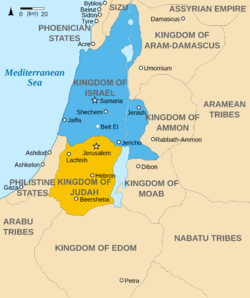Kingdoms of Judah and Israel
The Kingdoms of Judah and Israel existed side by side from around 930 BCE to 722 BCE, when the Assyrians destroyed the Kingdom of Israel and exiled most of its inhabitants.
< Kings : {Judges} -- United Monarchy (1047-930 BCE) -- Kingdoms of Judah and Israel (930-722 BCE) -- Neo-Assyrian Period (722-626 BCE) -- Kingdom of Josiah (626-609 BCE) -- Neo-Egyptian Period (609-605 BCE) -- Babylonian Period (605-539 BCE) -- {Second Temple Judaism}>
< People -- < Kings of Judah -- Kings of Israel >
Overview
Standard Biblical chronology suggests that around 930 BCE, following the death of Solomon, the United Monarchy split into a southern Kingdom of Judah and a northern Kingdom of Israel.
The existence of such United Monarchy is very dubious. Judah was the smaller kingdom and lived in the shadow of the more powerful Kingdom of Israel.
As the other kingdoms in the area Judah and Israel were subjected to repeated invasions by their powerful neighbors. The Egyptians and the Assyrians did not established permanent empires but frequently invaded and plundered the country. At the same time Judah and Israel were often at war with the other kingdoms of the area.
The Books of Kings state that soon after the split (around 925 BCE) Pharaoh "Shishaq" invaded the country plundering Jerusalem. An inscription (the Bubastite Portal) over a gate at Karnak in Egypt recounts such an invasion by Pharaoh Sheshonq I. Among the conquered cities are the ancient Israelite fortresses of Megiddo, Taanach and Shechem.
In 854 BCE, according to Assyrian records (the Kurkh Monoliths) an alliance between King Ahab of Israel and Ben Hadad II of Aram Damascus managed to repulse the incursions of the Assyrians, with a victory at the Battle of Qarqar. This is not included in the Bible which describes conflict between Ahab and Ben Hadad.
The Mesha Stele, also known as the Moabite Stone, is a stele dated around 850 BCE containing a significant Canaanite inscription in the name of King Mesha of Moab (a kingdom located in modern Jordan). Mesha tells how Chemosh, the god of Moab, had been angry with his people and had allowed them to be subjugated to Israel, but at length, Chemosh returned and assisted Mesha to throw off the yoke of Israel and restore the lands of Moab. The inscription seems to parallel an episode in 2 Kings 3: Joram (Jehoram) of Israel makes an alliance with Jehoshaphat king of Judah and an unnamed king of Edom (south of Judah) to put down his rebellious vassal Mesha; the three kings have the best of the campaign until Mesha, in desperation, sacrifices to his god Chemosh either his eldest son or the eldest son of the king of Edom; the sacrifice turns the tide, "there came great wrath against Israel", and Mesha apparently achieves victory.
The Tel Dan Stele (ca. 840 BCE) recorded the death of the King of Israel Joram and the king of Judah (Ahaziah), by the king of Aram-Damascus Hazael.
Around 750 BCE, the Kingdom of Israel was destroyed by Assyrian king Tiglath-Pileser III and annexed in the Assyrian Empire. The Philistine kingdom was also destroyed. The Assyrians sent most of the population of the northern Israelite kingdom into exile, thus creating the "Lost Tribes of Israel". The Samaritans claim to be descended from survivors and colonists of the Assyrian conquest. An Israelite revolt (724–722 BCE) was crushed after the siege and capture of Samaria by the Assyrian king Sargon II.
List of Kings of Judah and Israel
- See Kings of Judah and Kings of Israel
